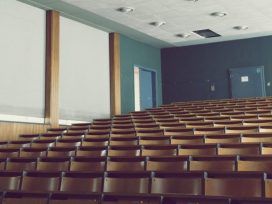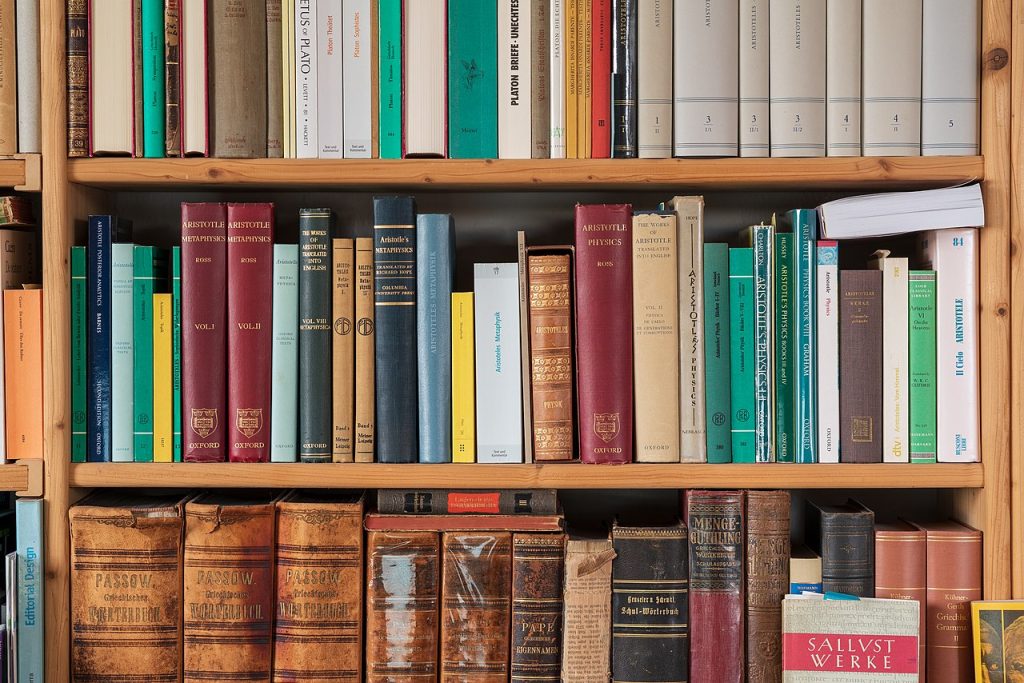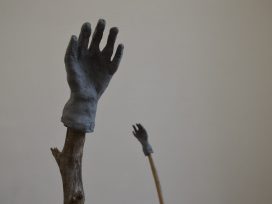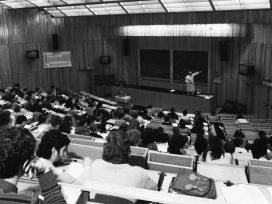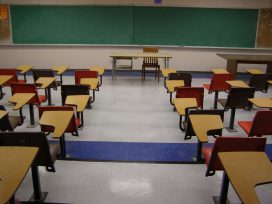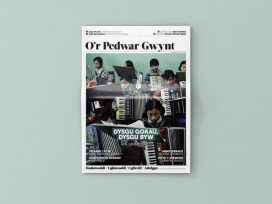One of the most notable recent developments in European higher education is the emergence of the liberal arts and sciences movement. In the past 30 years, over 100 programs identifying with this educational philosophy have been created all over Europe, including significant numbers of programs in the Netherlands, the UK and central Europe. The Bologna Process, initiated in 1999, played an important part in this development. Facilitating the exchange, co-operation and common recognition of degrees, the Process was an effort on the part of European countries to harmonize and improve higher education across the continent.
Traditionally, most higher education in Europe has been organized around mono-disciplinary programs, such as law, economics or medicine, that are primarily aimed at preparing students for particular professional careers. These programs typically employ traditional pedagogies, such as lectures and closed-book exams that ask students to reproduce material they have studied. The relationship between teachers and students is fairly transactional here, and education tends to be seen as a formal process of following courses, doing assessments and receiving credits for those assessments until all requirements have been met and a degree is issued.
In stark contrast, liberal arts and sciences programs offer students a much more diverse curriculum, combining a broad general education in a range of subjects (usually involving a core curriculum of required courses) with more specialized study in a number of related disciplines. Students are often given considerable freedom of choice in which courses to take. These programs stress holistic development, the cultivation of generic intellectual skills and intrinsic academic motivation over narrow professional preparation. They offer active, student-centred pedagogies, with small classes, tutorials and individual supervisions, and see education in distinctly relational terms, trying to create an academic community of learners who not only study together but also engage outside of the classroom in a social and extra-curricular context, sometimes living together on a residential campus.
In the wake of the most visible reforms of the Bologna Process, however, the impetus for further reform has waned, and, perhaps as a result, the growth in the number of liberal arts and sciences programs has slowed. This raises the question of how the liberal arts and sciences movement will continue to develop, and what its future place in the European higher education system will be. Was it a movement bound up with particular circumstances that facilitated its growth, doomed to stagnation now that those circumstances no longer obtain? Or will liberal arts and sciences programs continue to exert an influence over the future of university education in Europe
This is a timely issue to consider, as the Covid-19 pandemic has placed higher education on the cusp of another transformative moment. The experience of conducting higher education online for two years has upended traditional ways of providing education and forced educators to innovate in several respects. As the world emerges from the pandemic, it seems highly unlikely that everything will return to business as usual. As programs go back to in-person teaching, they must decide which innovations they will continue to use, and which aspects of their pre-pandemic educational model they will seek to reinstate. This may provide another occasion to rethink higher education, which could create new opportunities for the liberal arts and sciences movement.
To address these issues and speculate about what is next for the liberal arts and sciences movement, it is important to understand the relationship between the movement’s emergence and the context of the Bologna reforms. Once we understand the factors that explain the success of this movement, it will be possible to ask how those factors have changed over recent years, and what these changes mean for the future of liberal arts and sciences in Europe.
Liberal arts and sciences & the Bologna Process
As a rough and rudimentary theory of innovation in higher education, one might say that educational innovations depend on three sets of conditions. First, there must be a recognition that the system faces problems or challenges that need to be addressed. After all, if everything were perfect, no institution would contemplate reform. Second, there has to be an opportunity for reform, some willingness to rethink what higher education is and should be and some possibility of creating new programs or implementing innovations. Third, there must be proposed educational innovations that plausibly claim they can address the challenges at hand, and which can be advocated for on those grounds. The emergence of liberal arts and sciences in Europe can be understood as following from these conditions.
At the time of the Bologna reforms, there were various concerns about the state of higher education in Europe. Three, in particular, seem to have been important in the development of liberal arts and sciences. First, there was an intellectual concern: that discipline-based programs did not do justice to the increasingly important role played by interdisciplinarity, both in science and in society at large. It was becoming apparent that the most complex and difficult problems students would face in their working lives were not solvable with the insights and methods of a single discipline. Narrow disciplinary programs were moreover unlikely to meet students’ interests as they developed during their education, resulting in high student dropout rates. Second, there was a methodological concern that the traditional methods of higher education were proving pedagogically ineffective and alienated students. It was particularly noted in the Netherlands that the massification of traditional higher education had resulted in an educational environment that was insufficiently challenging to the most gifted students, and that large-scale, impersonal teaching catered to the ‘lowest common denominator’. As such, the system was insufficiently differentiated for students of different abilities and levels of ambition. As a result, students often were not particularly engaged with their education, did not optimally develop their cognitive faculties and took a long time to finish their degrees. Finally, there was concern that an education conceived solely as preparation for students’ economic future was a socially impoverished one. Civic engagement and interpersonal development were also seen as important functions of higher education, and they needed to be nurtured as much as academic competencies. This was especially relevant to central and eastern European societies, whose recent history of Communism underlined the importance of civic education.
Amidst these concerns, the Bologna Process forced universities across the continent to create undergraduate programs as the first cycle of higher education. The idea was that this would make it easier for students to complete their undergraduate studies at one university and then do their graduate studies elsewhere or work in another European country. As most European higher education systems did not have a separate undergraduate phase, they were obliged to consider how to implement one, and what its focus should be. Should it simply reproduce the first years of existing programs? Or should it be a distinctive phase, with its own goals and methods? It is easy to see how the liberal arts and sciences model might offer an attractive way of conceptualizing the undergraduate phase in the context of higher education’s perceived shortcomings and challenges. This curriculum, combining multiple disciplines, would encourage interdisciplinary thinking, while its active pedagogy, with emphasis on small-scale, student-centred forms of education, would be much more engaging to students, stimulating their learning and improving their results. The focus on community, and on students not only studying but also socializing together, would yield an education concerned with more than just economic and professional goals. All these factors together would result in a more intensive experience that would challenge even the brightest and most motivated students.
There are currently over 100 programs in Europe that, in their own way, follow this model, with over 20 programs in the UK, more than 10 in the Netherlands and a string of programs in central Europe. These programs have achieved, in many cases, a considerable degree of prominence in terms of the achievements of their students and the quality of their teaching.
Liberal arts and sciences after Bologna
While the spread of liberal arts and sciences within European higher education is certainly notable, one should not exaggerate matters. To meet the requirements of the Bologna process, most institutions simply divided their existing programs into two, the first three years being re-designated as the undergraduate phase and the final year renamed as the Master’s program, without much educational innovation at all. Throughout Europe, less than one per cent of students study in a liberal arts and sciences program. Many European nations have no such programs, and, even in the Netherlands and the UK, students in liberal arts and sciences programs are still frequently called upon by prospective employers, as well as friends and family members, to explain what exactly they are studying. The Bologna process did not result in the wholesale reconceptualization of undergraduate education in Europe. Moreover, while there was a period between 2005 and 2015 in which many new liberal arts and sciences programs were founded, recent years have seen a marked decline in the number of new programs, and there seem to be few new ones in the pipeline. Hence it seems that the development of liberal arts in Europe has reached a plateau.
This might be explained by the fact that the opportunity that the Bologna reforms presented has passed, and the creation of the Bachelor’s/Master’s system is largely complete. While it is, of course, still possible to establish new programs and reform old ones, there is less impetus for change, let alone for the kind of systemic reimagining that inspires radical transformation. Moreover, the problems that spurred the development of liberal arts and sciences no longer support the case for this educational model in quite the same way.
While, for instance, the case for interdisciplinarity is now generally accepted, alternative educational programs have arisen that also cater to this need, sometimes inspired by the success of liberal arts and sciences. These include global studies, variations on the ‘philosophy, politics and economics’ concept (such as ‘politics, psychology, law and economics’; or ‘philosophy, politics, history and economics’), general natural sciences programs and other programs that combine disciplines without juxtaposing breadth and depth with freedom of choice in the way liberal arts and sciences do. Moreover, existing disciplinary programs are increasingly adding auxiliary disciplines to their curricula, allowing, for example, law students to also take a few economics courses. In short, it has become clear that liberal arts and sciences are hardly the only way of offering interdisciplinary education.
In terms of educational methodology, active student-centred pedagogies have increasingly been implemented in other programs. In some universities, traditional lectures have been replaced by, or supplemented with, tutorials or seminars, and more group work, presentations and essay assignments have been introduced. While there is still a lot of traditional education going on in Europe, liberal arts and sciences hardly have a monopoly on engaging pedagogies. It has become clear that student-centred pedagogies can also function in the context of traditional programs. Pedagogical discourse, what’s more, has moved away from an emphasis on stimulating excellence in the most gifted students towards an emphasis on accessibility and the mental health of all. Of greater concern than students working hard is that they have equal access to education and are not overburdened by their studies. In this context, the liberal arts and sciences agenda of creating more challenging and selective programs is not likely to be well-received.
Finally, the idea that higher education should include a civic dimension is no longer as popular as it once was. In central and eastern Europe, where this civic rationale for liberal arts and sciences was perhaps the most important, the moment for rethinking higher education in the light of the Communist past is over. It is possible, indeed, that this rationale was never particularly important in other parts of Europe. While some have argued that current social challenges, such as the influence of fake news, low democratic participation or the rise of authoritarianism might be met through higher education, this idea has not yet gained much traction within higher education or engendered much innovation.
In short, times have changed, and the conditions that fostered the rise of liberal arts and sciences programs after the start of the Bologna reforms no longer obtain. This raises the question of how the liberal arts and sciences movement will continue in the near future. Can it still have any relevance in a changing context?
The future of liberal arts and sciences
In thinking about what is next for the liberal arts and sciences movement in Europe, a number of scenarios can be imagined. It is possible that existing programs will continue only as niche operations in higher education, without much further growth or influence on the higher education landscape as a whole. Liberal arts and sciences programs would enroll a relatively constant number of students and cater to those who are attracted to their features, but merely as one among many different spheres of the higher education system, rather than prestigious harbingers of the future.
While, however, the development of liberal arts and sciences education might have slowed down, it has not come to a standstill. It is also possible that there could be slow but steady growth in the number of these programs, with new ones opening in places where liberal arts and sciences currently remain unknown. As existing liberal arts and sciences programs continue to send students into the labour market, it may be that they increasingly demonstrate their value to those not yet familiar with it, including universities in northern and southern Europe. As such, by building on their existing prestige, it may be that liberal arts and sciences go on to provide further direction for higher education reform.
Alternatively, it may be that only few new programs emerge, but that ideas from the liberal arts and sciences permeate the higher education system at large, influencing the shape of new and existing programs, even if these don’t strictly replicate the liberal arts and sciences model. One might imagine, for example, the inclusion of core and general education courses and student-centred pedagogies in traditional programs, more emphasis on academic community, the creation of physical spaces that foster extra-curricular activities, and a more relational approach to education. Universities might also create complementary studies programs that offer students in traditional, mono-disciplinary programs the opportunity to explore interdisciplinary issues in a small-scale setting that stimulates in-depth engagement.
Conclusion: Covid-19 as the new Bologna?
Which of these scenarios will materialize is hard to determine. It is possible that the Covid-19 pandemic will prove to have provided a new opportunity for reform and innovation in higher education, just as the Bologna Process once did. The pandemic has disrupted higher education and forced programs to adapt every aspect of the education they offer. As the acute phase of the crisis wanes and educators reconsider how to re-establish their practice, it seems unlikely that everything will return to how it once was.
Experience of the pandemic has also made clear precisely what the most urgent areas of innovation are. It may be that certain changes made to accommodate the unfortunate circumstances we have seen are worth keeping. For example, many educators might conclude that innovations in assessment that enabled students to do exams while retaining access to educational materials might better test students’ learning. Many students have also taken the opportunity to take courses in other programs, or even in other countries, as this suddenly became much easier in a world of virtual education. On the other hand, while certain students and educators may have found value in online education based on pre-recorded lectures and digital assessments, other students and policymakers have made outspoken calls for in-person education, emphasizing the importance of the relational aspects of higher education, and the efficacy of student-centred pedagogies. The pandemic thus seems to have provided both an opportunity for reform and several potential directions for it. The liberal arts and sciences model offers both a way of implementing this and a clear demonstration that an alternative model of education is possible. Given cultural shifts, however, and the high expense of running residential, stand-alone programs, it seems that the long-term influence of the movement is likely to manifest itself through innovations in other kinds of programs. Liberal arts and sciences programs can be usefully thought of as ambassadors of educational innovation, influencing the wider higher education system in a gradual, rather than a wholesale, way.
There is a chance that this potential future trajectory would advance the liberal arts model at the expense of existing liberal arts and sciences programs – victims, as it were, of their own success. Should the higher education system become more like liberal arts and sciences programs across the board, these programs would become less distinctive, and hence possibly less attractive. Such, however, is the fate of all successful teachers. They provide their students with knowledge and insights, but as students make these their own, they inevitably transform them, adapting these insights to their own needs and to the requirements of the times. So too, the lessons offered to higher education by liberal arts and sciences will be transformed in their application. It might make some early innovators nostalgic, but it is the only true mark of success.
